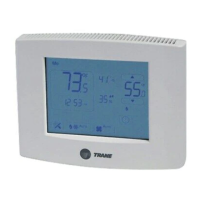Touch-screen Programmable
Thermostat
Installation, Operation, and Maintenance
June 2022
BAS-SVX44C-EN
Trane Part Number:
X13511538-01
Clarksville Part Number:
BAYSTAT152A
Service Part Number:
THT02775
SAFETY WARNING
Only qualified personnel should install and service the equipment. The installation, starting up, and servicing of
heating, ventilating, and air-conditioning equipment can be hazardous and requires specific knowledge and training.
Improperly installed, adjusted or altered equipment by an unqualified person could result in death or serious injury.
When working on the equipment, observe all precautions in the literature and on the tags, stickers, and labels that are
attached to the equipment.

